A lovely day in the country, followed by GruVee
Labels: austria, gruner veltliner
mainly wine...
Labels: austria, gruner veltliner
On Thursday evening, after the Sainsbury Press tasting, I headed over to Shepherd’s Bush with Tim Atkin for an Austrian wine dinner. The room was full of Masters of Wine (MWs) – they’d just had their AGM. And the purpose of the dinner was to celebrate the first non-Brit chairman of the Institute of Masters of Wine, Dr Pepi Schuller, who is Austrian, but rather exotically has a PhD from the University of Stellenbosch.
 Played football again tonight for the first time in ages, and it was great fun. I was really encouraged that while I felt knackered after 10 minutes, I stayed that way for a full hour without feeling totally knackered. Football is brilliant for fitness. You run a lot in short bursts, but because you are chasing a ball your mind is taken off the fact that your muscles and lungs are in real pain, and thus you cover much more ground, more pleasurably, than you would if you were jogging or running on a treadmill. Best of all, if you exercise regularly, you can drink more wine and eat more calorific foodstuffs (e.g. cheese) without becoming fat. Not that it's wrong to be fat. It's just that I have such a fragile ego I need to avoid becoming fat because I couldn't cope with other people's disapproval.
Played football again tonight for the first time in ages, and it was great fun. I was really encouraged that while I felt knackered after 10 minutes, I stayed that way for a full hour without feeling totally knackered. Football is brilliant for fitness. You run a lot in short bursts, but because you are chasing a ball your mind is taken off the fact that your muscles and lungs are in real pain, and thus you cover much more ground, more pleasurably, than you would if you were jogging or running on a treadmill. Best of all, if you exercise regularly, you can drink more wine and eat more calorific foodstuffs (e.g. cheese) without becoming fat. Not that it's wrong to be fat. It's just that I have such a fragile ego I need to avoid becoming fat because I couldn't cope with other people's disapproval.Labels: austria, football, Sauvignon Blanc
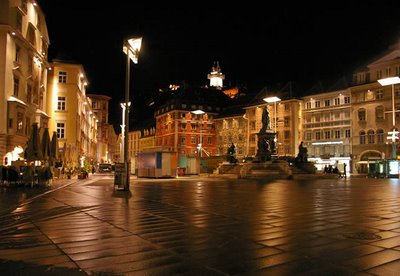 Back home after a wonderful few days in Austria. Graz proved to be a fantastic venue for the worldsauvignon conference: the organization was utterly perfect (in particular, good quality simultaneous translation into three languages is quite a feat), and it's a very easy city to spend some time in. It would be a nice place to live: big enough that there's cultural richness and some people to hang out with, but small enough that it feels relaxed and friendly. Pictured above, by night.
Back home after a wonderful few days in Austria. Graz proved to be a fantastic venue for the worldsauvignon conference: the organization was utterly perfect (in particular, good quality simultaneous translation into three languages is quite a feat), and it's a very easy city to spend some time in. It would be a nice place to live: big enough that there's cultural richness and some people to hang out with, but small enough that it feels relaxed and friendly. Pictured above, by night.Labels: austria, Sauvignon Blanc
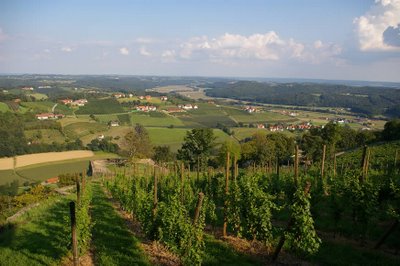
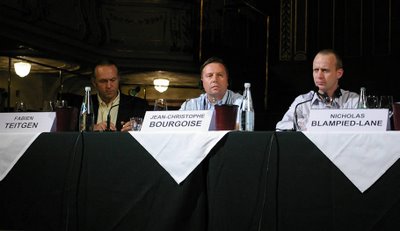 Then there was a panel tasting looking at the ageing potential of Sauvignon Blanc. If the conclusion of our clones panel was that it's a bit of a non-issue, then the conclusion of this panel was don't bother ageing Sauvignon Blanc. [Maybe I'm being a bit naughty here.] I just loved the typo in Jean-Christoph Bourgeois' name (pictured).
Then there was a panel tasting looking at the ageing potential of Sauvignon Blanc. If the conclusion of our clones panel was that it's a bit of a non-issue, then the conclusion of this panel was don't bother ageing Sauvignon Blanc. [Maybe I'm being a bit naughty here.] I just loved the typo in Jean-Christoph Bourgeois' name (pictured).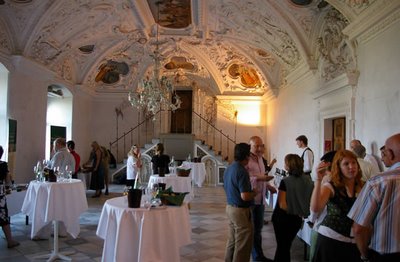
Labels: austria, Sauvignon Blanc, wine science
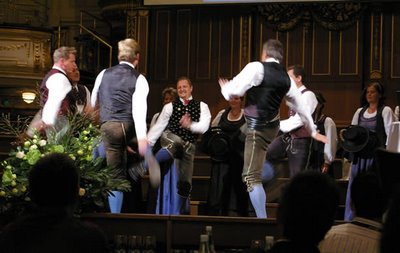 A very successful first day of the World Sauvignon Congress, held here in sunny Graz. 250 delegates are attending, representing 30 different countries. The proceedings began with an hour's opening ceremony, which contained several speeches, as well as some country dancing and a performance by a folk group, as well as an anthemic four-piece brass band. There were also appearances from the three 'princesses of wine', pretty Austrian girls selected for their attractiveness but also their knowledge of all things vinous. Pepe Schuller MW revealed that his wife is an ex-wine princess.
A very successful first day of the World Sauvignon Congress, held here in sunny Graz. 250 delegates are attending, representing 30 different countries. The proceedings began with an hour's opening ceremony, which contained several speeches, as well as some country dancing and a performance by a folk group, as well as an anthemic four-piece brass band. There were also appearances from the three 'princesses of wine', pretty Austrian girls selected for their attractiveness but also their knowledge of all things vinous. Pepe Schuller MW revealed that his wife is an ex-wine princess.Labels: austria, Sauvignon Blanc
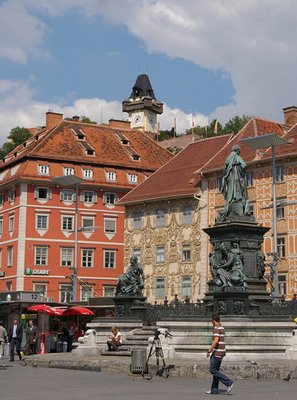 Arrived in Graz this afternoon for the Sauvignon Congress. I'm staying at a wonderful traditional hotel in the old town, Erzherzog Johann, which is in the best part of a small city that just falls short of being beautiful (although it has a lovely laid back feel to it). Conference sessions start tomorrow, but this evening there was a reception and dinner at the Schlossberg, which is perched on top of a steep hill in the town centre, accessible by a steep path or furnicular car.
Arrived in Graz this afternoon for the Sauvignon Congress. I'm staying at a wonderful traditional hotel in the old town, Erzherzog Johann, which is in the best part of a small city that just falls short of being beautiful (although it has a lovely laid back feel to it). Conference sessions start tomorrow, but this evening there was a reception and dinner at the Schlossberg, which is perched on top of a steep hill in the town centre, accessible by a steep path or furnicular car.Labels: austria, Loire, Sauvignon Blanc, Styria
In the morning I leave for Austria. More specifically, Graz, for the World Sauvignon Congress, where I have to sing for my supper by moderating a session on clones.
Labels: austria, Sauvignon Blanc
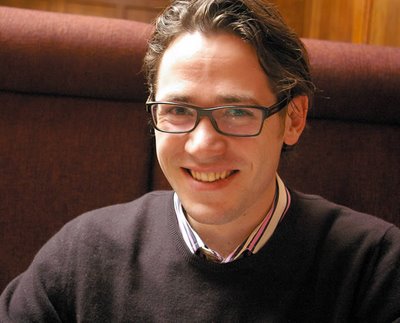 I met with young Austrian winemaker Hannes Sabathi (pictured) today for lunch.
I met with young Austrian winemaker Hannes Sabathi (pictured) today for lunch.Labels: austria, Chardonnay, london, Pinot blanc, Pinot gris, restaurants, Sauvignon Blanc
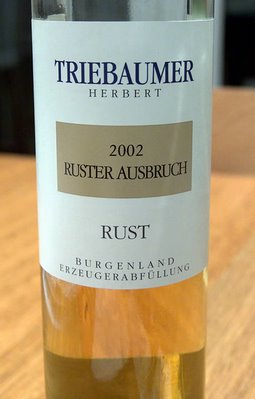 Two real hits last night, my last in the UK for a while - I'm making this entry from the business class lounge of Iberia en route to Santiago. It's quite nice being able to use an airline lounge because I normally fly economy. Anyway, these wines were just great - a fantastic full flavoured Champagne and a delicious Austrian sweetie.
Two real hits last night, my last in the UK for a while - I'm making this entry from the business class lounge of Iberia en route to Santiago. It's quite nice being able to use an airline lounge because I normally fly economy. Anyway, these wines were just great - a fantastic full flavoured Champagne and a delicious Austrian sweetie.Herbert Triebaumer Ruster Ausbruch 2002 Burgenland, Austria Yellow/gold in colour, this is a rich, almost pungent sweet wine with lifted aromas of cantaloupe melon and apricot, alongside spicy and herbal notes. The palate is viscous (163 g/litre residual sugar) with bold, concentrated flavours of ripe apricot, citrus and melon, together with some spicy complexity. It’s a serious wine of real class and intensity that just manages to stay balanced despite the immense sweetness. 93/100 (£21.95 Great Western Wine)
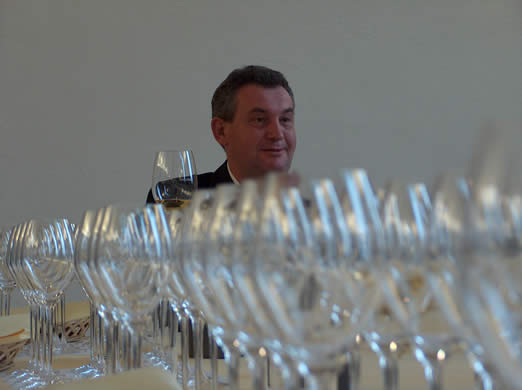
Labels: austria
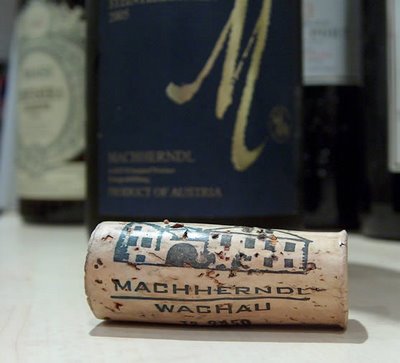 Forgive the rather melodramatic title to this post. I guess I was led to it by my current enthusiasm for Austrian wine, and also - despite my silly comments - about Riesling.
Forgive the rather melodramatic title to this post. I guess I was led to it by my current enthusiasm for Austrian wine, and also - despite my silly comments - about Riesling.A few days ago I reported on the Sepp Moser 'Minimal' Gruner Veltliner (here), which is made without any sulfur dioxide additions. I compared this 2005 with the regular 2006 from the same vineyard. Well now I have my hands on a 2005 to do a better comparison with, and I also have some of the 2005 Minimal left in the fridge.
Labels: austria, gruner veltliner, natural wine
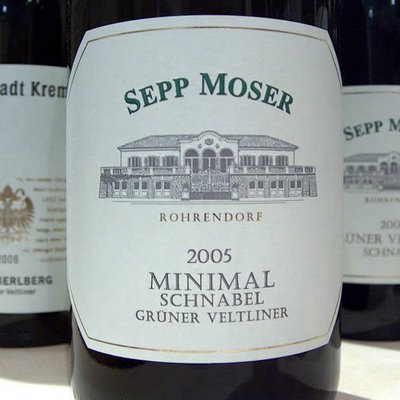
Labels: austria, gruner veltliner, natural wine
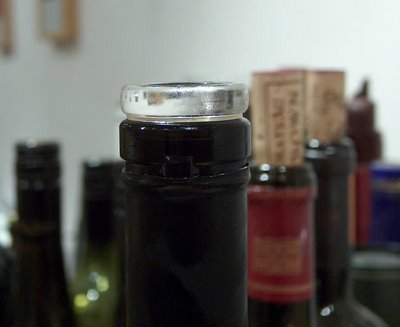 Some bottles opened last night, and continued tonight, remind me why I do what I do: I love wine!
Some bottles opened last night, and continued tonight, remind me why I do what I do: I love wine!Labels: austria, Bordeaux, closures, gruner veltliner
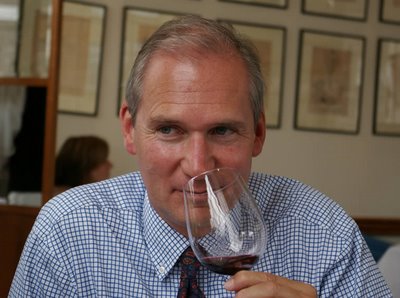
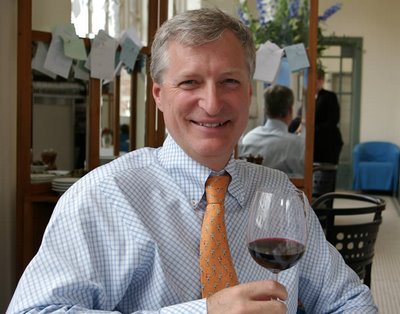 Began today with Tesco's press tasting at County Hall. The Tesco team were beaming with pride as they launched their new range: all 180 wines on show were new additions. Dan Jago was bursting with boyish enthusiasm - he makes everything he does look very easy, as if he's just having a bit of fun. I suspect the reality is that it's like watching a swan cross a pond: on the surface everything looks smooth, but under the water those legs are paddling like crazy. I also discussed football with fellow Man City fan Jason Godley. Interesting times.
Began today with Tesco's press tasting at County Hall. The Tesco team were beaming with pride as they launched their new range: all 180 wines on show were new additions. Dan Jago was bursting with boyish enthusiasm - he makes everything he does look very easy, as if he's just having a bit of fun. I suspect the reality is that it's like watching a swan cross a pond: on the surface everything looks smooth, but under the water those legs are paddling like crazy. I also discussed football with fellow Man City fan Jason Godley. Interesting times.Labels: austria, california, napa
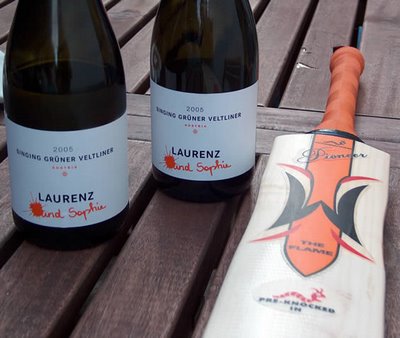
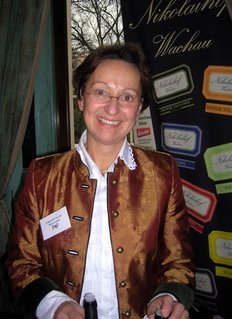 Big tastings. We all go to them. Have to. But we all hate them. Not for the fact that we get to meet lots of producers and colleagues: that's what these events are good for. But because it's really hard to do wines justice when you are tasting one after another in an often crowded, noisy environment where it is very hard to concentrate, and where your palate definitely undergoes some sort of transformation in response to the physical assault of repeated challenge by acidic, alcoholic and frequently tannic liquids.
Big tastings. We all go to them. Have to. But we all hate them. Not for the fact that we get to meet lots of producers and colleagues: that's what these events are good for. But because it's really hard to do wines justice when you are tasting one after another in an often crowded, noisy environment where it is very hard to concentrate, and where your palate definitely undergoes some sort of transformation in response to the physical assault of repeated challenge by acidic, alcoholic and frequently tannic liquids.Labels: austria, biodynamics
Lunch with Lenz today. Lenz Moser is a name you'll probably be familiar with: his grandfather established a very successful winery under the name, which got into financial difficulties in the mid 1980s and was sold. Lenz (the fifth) ran this company for a while, and then became manager of European operations for the Mondavis. He left this job when he got wind of takeover talk, and decided to set out on his own a couple of years back. His new focus is purely on Gruner Veltliner, of which he makes a range of three.
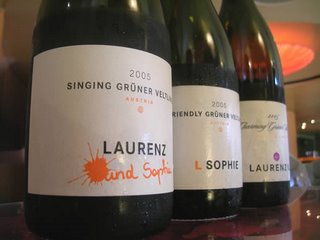 Friendly Sophie is rounded, accessible, generous and quite fruity, but transparent and fresh at the same time. Charming Laurenz is a bit more serious, with a bit of minerality and pepper spice, and good acidity. Singing Sophie is somewhere in between - a fresher, more zingy version of the Friendly Sophie, but still with a nice fatness to it.
Friendly Sophie is rounded, accessible, generous and quite fruity, but transparent and fresh at the same time. Charming Laurenz is a bit more serious, with a bit of minerality and pepper spice, and good acidity. Singing Sophie is somewhere in between - a fresher, more zingy version of the Friendly Sophie, but still with a nice fatness to it.Labels: austria